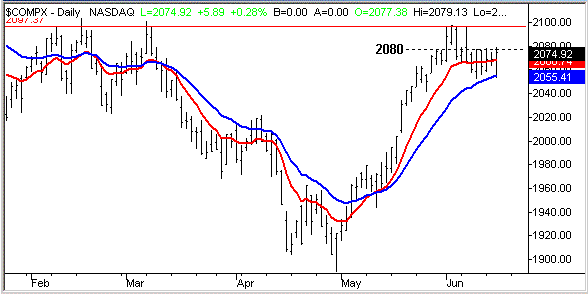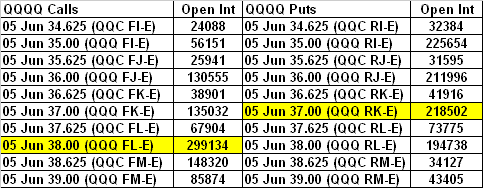Yesterday, the indexes were a little in the red and it looked like we were on a course for another minor loss for the week. But when the bulls got back from lunch, they were apparently in a buying mood - stocks fully recovered, and the indexes managed to make a little gain. The volume behind the move was decent too, so the bulls should have at least a little to be excited about, right? Well, yes, no, and maybe. Any gain is bullish, but there are a couple of things that we see that could contain stocks for the rest of the week. In other words, let's not get too excited yet. The fact of the matter is that the market is still at a pivot, and we may not come out of it until next week.
First, a quick look at the NASDAQ's chart. After hitting a low of 2053.39, the NASDAQ rallied back up as high as 2079.13. Not bad, but that resistance still stands just under 2080. The only thing we did yesterday was span the recent range. With this being an expiration week (option expiration is Friday), there are some underlying pressures to keep the indexes close to where they started last week. More on this below. As far as the chart of the NASDAQ is concerned, we're still just treading water. The point is, don't read too much into Wednesday's rebound. It was small, and didn't break above resistance at 2080. And even if resistance is broken there, there's another strong resistance line at 2100. On the flipside, the support at the 20-day line is strong too. Like we said, these two opposing forces are likely to keep the NASDAQ contained. Take a look at the chart below, then read on for some more thoughts about today and tomorrow.
NASDAQ Composite

But there's something else that could be keeping the markets close to their current levels. Friday is an option expiration day. In fact, it's a triple-witching day, when monthly as well as quarterly options expire (not to mention futures). What that basically means is that anyone who owns an expiring June option or future is going to be forced to make one of three decisions -- either exercise it, sell it, or let it expire. With as many traders using futures and options now, and all of them being forced to choose at the same time, you'd think the market would be highly volatile. And actually, it used to be that way. But as traders have learned how to handle an expiration, and more importantly, how to plan for it, these expirations have actually become quite tame. In fact, the few days leading up to an expiration have actually become a little predictable. That's because the market can see the "open interest" on any given option contract. With knowing how many put options or call options at a particular strike price are issued, all the bears and the bulls basically have an exposed poker hand. In other words, knowing what both sides are thinking leaves the market indexes stuck right in between those two bets and neither side really wins.
Confused yet? Don't be. It will all make sense when we work through an example. This idea applies to most any index that has options traded on it, but I prefer to use a real trading instrument, like the QQQQ's or the DIA's. They're tangible, which can be a factor. Most indexes aren't tangible, so to speak, so the pricing of the options and the pricing of the underlying index may not always match up in quite the right way. Let's look at the "open interest" for the June options on the NASDAQ 100 QQQQ's.
On the table, we have strike prices ranging from 34.62 to 39.00, with both puts and calls displayed. Most of the open interest on the call (bullish) side is with the 38 strike. The highest open interest on the put (bearish) side is at the 37 strike. So which side is going to end up being right, and end up with their option being in the money? Generally speaking, neither. The idea is that the market will gravitate to the level that creates the "max pain" (a term that isn't completely accurate) for the majority of traders. In this scenario, if the QQQQ's close on Friday parked between 37 and 38, that will dissappoint the greatest number of investors - all those 38 calls and all those 37 puts will be worthless. Take a look, then read on for our final thoughts.
QQQQ June Option Open Interest

So what causes this to happen? First, it's not a guarantee. There are exceptions to this phenomenon, but they're rare. But as far as what causes it to happen, it's the combination of several things. Primarily, many of the calls that are in the money (strikes under 37) are being exercised, which can pull the QQQQ's lower. Conversely, all the puts that are in the money (with strikes over 38) are also being exercised, pushing the QQQQ's higher. The middle ground of both of those forces is, as you might guess, right in between those two strikes. So, the QQQQ's closing at an average price of 37.64 over the last four days isn't a real surprise. It's right about where they should be. The implication is that until all that pressure is released, the QQQQ's will be stuck in between those two prices. What will release that pressure? When the options expire on Friday after the close, traders will no longer be forced to make that choice and the market can resume trading as normal.
Now that you have the theory, see if you can apply it to the indexes. It works pretty well there too. It's also something to keep in mind if you feel like the market has stagnated over the last few days, because it really has.
Price Headley is the founder and chief analyst of BigTrends.com.